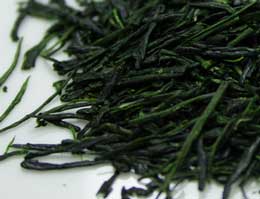Vicony Tea Directory


Gyokuro(玉露)
 |
|
| Gyokuro- Dried Tea Leaves |
Gyokuro Tea Introduction
Gyokuro is commonly seen as one kind of top quality Japanese green teas. However, this tea is completely different from Sencha. It is not just only a superior version of Sencha, but a different category of Japanese green tea. Gyokuro is very deep green in appearance with a flavor like seaweed and mellow taste. In fact, Gyokuro is produced from the same tea cultivar as Sencha while special method is needed to be used in Gyokuro production. About 20-30 days in advance before plucking, entire tea garden is covered by black-colored sheet. Due to the lack of sunshine, tea tree is trying to survive, resulting in physiological changes and even leading to chemical composition change including the typical flavor substances of Gyokuro.
Gyokuro History and Producing Areas
Gyokuro was invented in year 1835. Tea garden was traditional covered by the bundle rice straws. Nowadays, Asahina (Shizuoka), Uji (Kyoto) and Yame (Fukuoka) are three major Gyokuro manufacturing areas in Japan.
Around 30 days in advance before plucking tea leaves, tea gardens are covered with a black sheet. The penetration rate of sunshine for the first 7-10 days is 65-70%, and then is 97-98%. The theanine which is a kind of amino acid and produced from the root will be transfered to the stem and leaves. Theanine is the substance which gives tea sweetness. Green tea which contains higher percentage of theanine produces mellower taste, on the contrary, tea leaves which contain a higher proportion of polyphenol such as catechins gives a bitter taste. When tea leaves are exposed to sufficient sunshine, theanine is degraded and converted into catechins. Therefore, blocking out the sunshine will inhibit the biosynthesis of catechins and theanine is proportionally increased. In other words, the typical taste of Gyokuro is made by blocking out the sunshine from the tea leaves.
The typical aroma of Gyokuro which is often associated with seaweed is caused by the substance named dimethylsulphite. The precursor of dimethylsulphite is called methylmethioninesulphonyl. This substance is also accumulated in tea leaves when tea gardens are blocked from sunshine. During the following process when tea leaves get steamed, methylmethioninesulphonyl subsequently converts to dimethylsulphite.
The brewed Gyokuro leaves are deep green in color compared with Sencha which is yellowish green. When tea gardens are covered without sufficient sunshine, more chlorophyll will be produced and rise to the surface of the tea leaves in order to carry out photosynthesis. This is the reason why Gyokuro has a deep green shade.
See Also:
- Green Tea
- Ching Wo Tea
- Tai Ping Hou Kui
- Chun Mee Tea
- Gunpowder Tea
- Da Fang Tea
- Huo Qing Tea
- Huangshan Maofeng
- Da Hong Pao Tea
- Lapsang Souchong

| Green Tea | Black Tea | White Tea | Yellow Tea | Oolong Tea | Dark Tea | Pu Erh | Scented | Flowering | Herbal | Tea Powder |
| Navigation |
| Home (ViconyTeas) |
| Tea Directory (VTD) |
| Tea Importers |
| Tea Exporters |
| Tea Wholesalers |
| Informative Tea Web |
| Tea Association |
| Tea Encyclopedia |
| Online Tea Shop |
| Tea Dictionary Online |
Copyright©2016 | Gyokuro
